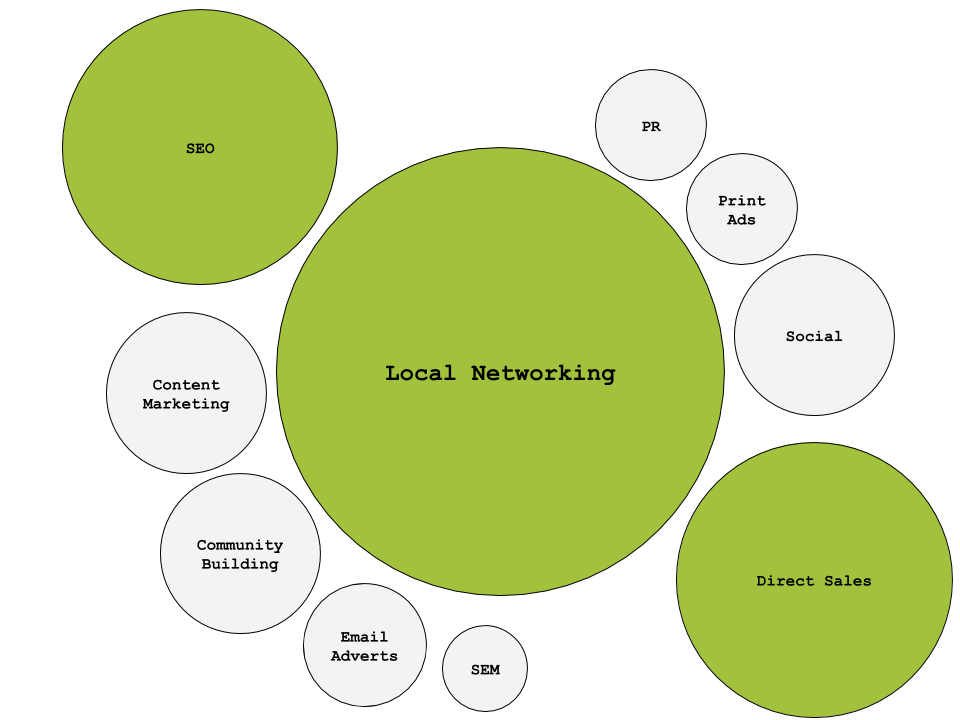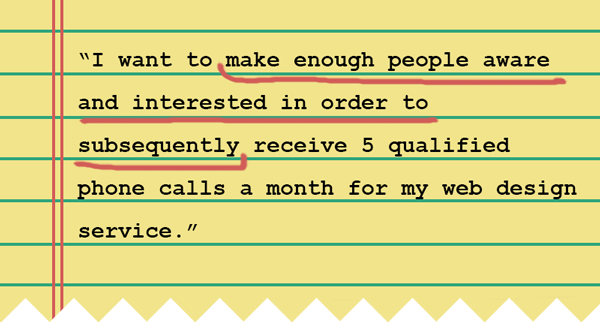When it comes to improving your bottom line, there’s effectively only 2 things you can do:
- Charge more for your product (A and D in the diagram below).
- Sell your product to more people (A and B in the diagram below).

Since you’re trying to do all this networking in Atlanta, I’ll assume that your current goal is the latter (to sell to more people), but still: there are so many different ways to do this!
It was not until after reading the book Traction (pictured below) by Gabriel Weinberg and Justin Mares that this became abundantly clear to me.

To get more eyes on your product (or service), you could:
- Run some social media ads on LinkedIn, Facebook, or Pinterest.
- Learn how to effective use SEM (Search Engine Marketing) and run some ads (this book is a great place to start).
- Purchase a billboard.
- Hire a PR firm.
- Do something ridiculous to get people talking about you.
- Do some direct sales via cold-calling.
- Foster an online community through email marketing.
- Write some fantastic content and do content marketing
Some of these methods give you a ton of leverage (high value to time spent ratio), and others require a significant amount of your personal time.

As you can see, in-person networking is probably the most time consuming traction channel you can choose. So you have to be completely sure that it’s right for your current business strategy!
That’s why in this section, we’re going to help you define networking goals that are both achievable, and tied directly to your business objectives.
Specifically, we’ll…
- Evaluate the need and the real cost of local networking.
- Define some effective networking goals that we can work with throughout this guide.
- Set you up with a quick primer on why focus is so important.
Let’s get started.
What’s the Need?
We’re going to find out if networking events make sense for your business in this section. We’ll start with the numbers, and then step back to the business goals.
| What’s The Cost?
First, grab a pencil and a napkin: we’re going to do some math (I know, I know, it’s supposed to be about networking, but as you know: everything truly does come down to dollars in business).
- Define how much a new client/customer means to you in dollar amounts. We’re talking LTV here, so take up-sells and referrals into account here.

- Determine how much time you’re going to be investing, in terms of hours, if you focus on networking exclusively for one month.

Note: I’ve found that finding and attending more than 20 events per month is really hard, so it’s a good starting number.
- Multiply this number by 50 (or whatever your hourly rate is to justify your cost of living) to determine the dollar cost of that time.

- Calculate how many customers you’ll need to “break even”

Note: Keep in mind that money now is worth more than money later, so we’ll have to adjust this number to make it feasible in the real world.
- Pick a number between 1 and 10. This is going to be your risk tolerance factor: the lower the number, the higher the risk tolerance.

- Multiply your Break-Even Point by this number.

- Determine if you can feasibly hit this number through networking. If the answer is yes, then press on! If the answer is no, you may want to reconsider this channel (with a few exceptions, discussed below).
| What about your business requires local business owners?
Another important consideration besides the cost of course, is to evaluate the importance of local customers.
This leads us to 1 of 4 possible situations:
| Some Exceptions to The Rule
There are 2 situations in which you should still network even if at first it’s not financially feasible for you.
- You’re business is a startup; or
- The event is designed heavily in your favor.
If you’re just getting started, it’s important to do things that don’t scale to get those first few key customers. So get out there and hit the bricks to get your foot in the door: this guide will help you do this effectively.
Also, if the event is designed heavily in your favor (i.e. you’ve been invited to present at an event versus simply participate), you should more than likely attend. The chance to expose yourself as an authority figure to 500+ potential customers in an hour is not something that any business should overlook!
Now that we’ve decided if networking is for us, let’s set a SMART goal so we can start taking action.
Setting Networking Goals
As you already know, setting goals is essential to progress in any domain. Don’t get me wrong, you can still make it without goals, but it’s much more proactive to have one before you start shooting in the dark (and you’re much more likely to be successful).
| Setting an Effective Goal
There are 2 principles to setting effective goals:
- It has to be tied to a specific business objective.
- It has to be a SMART goal (we’ll go over this in a bit).
So first, let’s draft a goal that is tied to a business objective.

Alright, this is good. We’ve successfully answered the “what”.
But what’s missing?
You guessed it: there’s really no way to effectively track this goal. How would you start taking action towards this goal? Just “get more phone calls”?
The solution to this is to simply transform the goal into a SMART goal:

So let’s take a step back and evaluate our goal again. First, let’s make it more specific.

Is this measurable? Could I come back and examine the effectiveness of my actions vs. the goal? More or less, but it could be better, and we’ll do that as we continue to refine it.
Is the goal actionable? Not really. There is nothing that I can directly do to make this goal a reality, so let’s make a change:

That’s a little better, let’s keep going. Is the goal relevant? No: this is where we answer the “why?”.

We’re getting there! Let’s make the goal time-bound:

Finally, let’s comb over the criteria again and make a few more tweaks:

As you can see, we made the goal much more actionable (what I’m going to do), and relevant (added an additional “why”).
Beautiful! Now there’s a goal you can start moving towards right this minute.
Now, as you start to move towards actually finding some events, you can look back at this goal to determine the kinds of events you should attend.
Focus! (..well, for 1-2 months)
I recommend that if you choose to pursue networking more aggressively, that you take one to two months and focus on networking exclusively.
This means avoiding distractions in other marketing channels. Focus on product development, then go out and talk to people.
I recommend this because it’s very easy to get overwhelmed when you’re doing too many things at once, and with networking specifically, it takes up quite a bit of your time. You’ll gradually start resenting your networking events more and more as you get bogged down with SEO, content marketing, and PR firms.
Further, it will be quite hard to evaluate the genuine effectiveness of networking if you’re not putting the effort in a focused manner. You’ll need to be following up, building relationships, and grabbing coffee. If you don’t have the time to do all of that you may end up abandoning networking because you think it’s ineffective, when in reality you simply didn’t have the bandwidth to do it effectively.
Towards the end of the month, you’ll notice that you’re becoming very fluid and natural at networking. Why is this? There’s two reasons:
- The 10,000 hour rule; and
- Exposure therapy!

Yes, networking is hard (and many people including myself hold certain anxieties about them), so as you push towards your 10,000 hours you’ll start to both learn the social dynamics (there’s a section on that in this guide, too) and feel more comfortable in the environment.
Then, when you’re done, do a quick retrospective to determine if you want to continue!
In closing, once you’ve
- Determined that networking is the right avenue for your business, and
- Set a SMART goal, you should
- Focus exclusively on networking for 1-2 months.
This is the best approach, and this how you’ll start dominating the local networking scene!
Now, let’s start finding some quality networking events to attend…
Take Me to Chapter 2: Finding Networking Events →